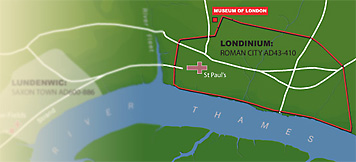The last days of Londinium
|
After AD 410 Britain was no longer part of the Roman empire. Roman Londinium became a ruined ghost city. But on settlements outside the walled area, it now seems that Roman civilisation continued for another generation.
|
 The Roman city of Londinium was not on the same site as the later Saxon town of Lundenwic
The Roman city of Londinium was not on the same site as the later Saxon town of LundenwicOver the years, soldiers were repeatedly withdrawn from Britain. The last remaining troops were recalled by Emperor Constantine III in ad 407 to deal with barbarian invasions in France. In ad 410 Britain sent an appeal for further troops to the Emperor Honorius, but he refused and suggested that the British towns organise their own militias. This marked the end of official Roman rule.
By the end of the 4th century, London’s southern settlement had been abandoned. On the northern side, large parts of the city inside the wall had been cleared of buildings and the sites covered with layers of dark grey soil. It is uncertain whether this earth was used for gardens or fields, or was wasteland. Houses remained in the south-east corner of the city, and some people were still living in London in the Roman style, still able to import luxuries.
By the mid-5th century the Roman settlement was empty. Londinium was a deserted ruin.
The significance of St Martin-in-the-Fields
Two discoveries at St Martin-in-the-Fields are making important revisions to the story. One was a kiln for making roof tiles, the other a stone sarcophagus containing the skeleton of a middle-aged man. Both these finds are dated to AD 400-450.
Therefore, even though Londinium itself had been abandoned, it seems that Roman civilisation continued in settlements outside the city walls for at least a generation.